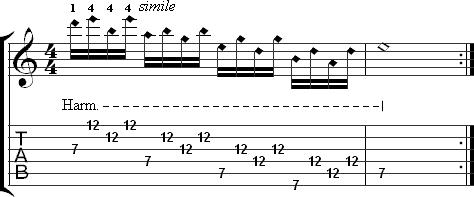What You Should Know
What You Will Learn
- How to find and play natural harmonics
- How natural harmonics are notated
How to Play Natural Harmonics on Guitar
What is a Natural Harmonic?
A natural harmonic is any harmonic that is produced on an open string. Natural harmonics can be played by simply plucking the string or by using other techniques like tapping, slapping, or pinching. This lesson will cover plucking the strings to produce a harmonic.
Notation
Harmonics in Standard Notation
Harmonics are notated in standard notation as a diamond shaped note that indicates the pitch of the harmonic. The diamond works just like a regular notehead, in that the notehead can be open or filled-in to specify the note value.

Reading harmonics in standard notation requires a comprehensive knowledge of the location and pitch of each natural harmonic. For this reason, you should use the tablature until you are familiar with where to find each harmonic.
Standard notation for harmonics often includes the 8va sign to indicate that the pitch is an octave higher than written.
Harmonics in Tablature
A natural harmonic is indicated in tablature by placing 'Harm.' above a number on the tablature staff. The number indicates the fret where the harmonic occurs. If several harmonics occur in a row, a dotted line will also be used to indicate that each note under the line is a harmonic.
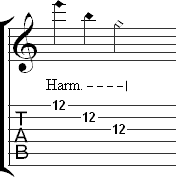
You may encounter other approaches to notating natural harmonics. The most common of these variations is to place the number in a diamond and omit the 'Harm.' text. Some music may use the text 'N.H.' instead of 'Harm.', which is an abbreviation of natural harmonic. Most publishers include a tablature guide in the music they publish, so refer to this to find out how to interpret any unfamiliar symbols. If a guide is included, it can usually be found in the front or back of the book.
The Technique
Harmonics are played by lightly touching a string at a specific point along a string. Once your finger is in place, the string should be plucked and your left hand finger removed from the string. The strongest harmonics occur at the twelfth, seventh, and fifth frets (in order from strongest to weakest). To play these harmonics, you need to place your finger directly above the fret. This is different from playing a fretted note where the finger needs to be behind the fret.
Review
The point on a string where a harmonic occurs is known as a node.
The finger can be lifted after the harmonic is played to allow the string to ring freely. However, this is not required. Leaving the finger on the string after playing the harmonic still allows the string to ring, but produces a slightly muffled harmonic. This sound may be desirable in some situations.
You can play harmonics with the tip of the finger or by flattening the finger to play harmonics at the same fret on several strings. If you flatten your finger, you can angle it slightly for each string to allow other strings to ring freely. This angling is an advanced technique, so you may need some experience with harmonics before trying it.
Exercises
Exercise 1
Exercise 1 is a simple repeated harmonic at the 12th fret of the fifth string. Because the harmonic is on one of the thickest strings and occurs at the twelfth fret, it should be fairly easy to play. Use this as an opportunity to experiment with the position of your finger and how much pressure you place on the string to produce the harmonic. Pay attention to where the harmonic is the strongest and how varying degrees of pressure on the string affect clarity of the harmonic.
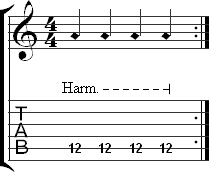
Exercise 2
Exercise 2 is a series of harmonics played on all six strings on the 12th fret. This can be played in two ways:
- 1. By flattening the finger (the index or middle finger is best) against the string and lifting it off the string as the harmonic is played. The finger is then rested on the string again to prepare for the next harmonic. If you position and angle your finger properly, it is possible to avoid muting harmonics you played previously. This is a more advanced technique, so it may take time to learn.
- 2. By using the finger tip. This approach has the advantage of not muting the string when you play successive harmonics.
Practice this exercise using both approaches.
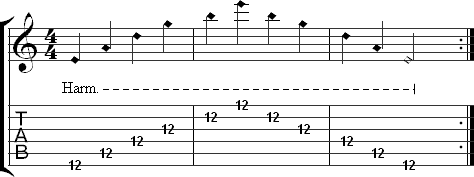
Exercise 3
The next two exercises are similar to Exercise 2. The harmonics are just played on different frets. It may be slightly more difficult to bring out the harmonics at the 5th and 7th frets. You may need to use a lighter touch with these than you did with the 12th fret harmonics.
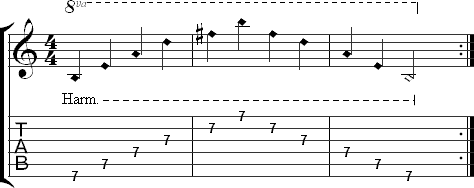
Exercise 4
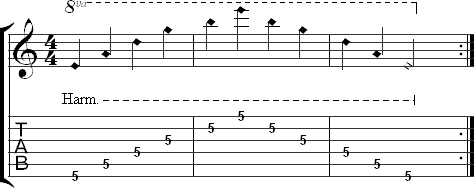
Exercise 5
Is is also possible to play multiple harmonics at once. This requires flattening a finger and pressing it lightly against each of the strings at the indicated fret. The harmonics on the top three strings produce a minor chord in first inversion. Exercise 5 demonstrates this concept. Make sure your finger is parallel to the fret when playing these harmonics so that you can bring out each harmonic cleanly. Angling the finger to the right or left may prevent some harmonics from ringing.
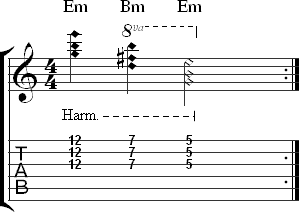
Exercise 6
Playing harmonics on the D, G, and B strings produces a major chord in second inversion:
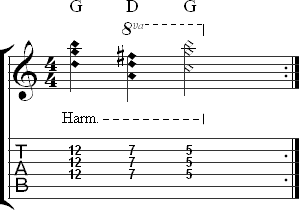
Exercise 7
Certain combinations of harmonics produce a cascading harp-like effect. The following exercise should be played with the tips of the fingers to allow each harmonic to ring as long as possible after it is played. This will contribute to the harp effect. Play the twelfth fret harmonics with the pinky and the seventh fret harmonics with the index finger. The seventh fret harmonics are weaker than those at the twelfth fret, so you will need to work on making the volume of the harmonics even.
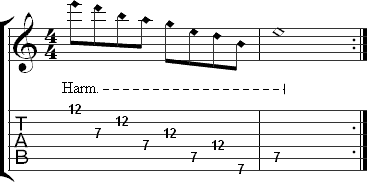
Exercise 8
Exercise 8 is another example of how harp-like effects can be created with harmonics.
